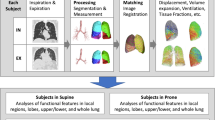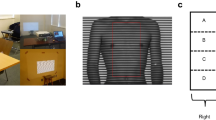Abstract
To assess the stability and reproducibility of different breath-hold levels in healthy volunteers and patients using dynamic MRI (dMRI). In ten healthy volunteers and ten patients with pulmonary hypertension (PH) and normal lung function craniocaudal intrathoracic distances (CCD) were measured during inspiratory and expiratory breath-hold (15 s) (in healthy volunteers additionally at a self-chosen mid-inspiratory breath-hold) using dMRI (trueFISP, three images/s). To evaluate stability and intraobserver reproducibility of the different breath-hold levels, CCDs, time-distance curves, confidence intervals (CIs), Mann-Witney U test and regression equations were calculated. In healthy volunteers there was a substantial decrease of the CCD during the inspiratory breath-hold in contrast to the expiratory breath-hold. The CI at inspiration was 2.84±1.28 in the right and 2.1±0.68 in the left hemithorax. At expiration the CI was 2.54±1.18 and 2.8±1.48. Patients were significantly less able to hold their breath at inspiration than controls (P<0.05). In patients CI was 4.53±4.06 and 3.46±2.21 at inspiration and 4.45±4.23 and 4.76±3.73 at expiration. Intraobserver variability showed no significant differences either in patients or in healthy subjects. Reproducibility was significantly lower at a self-chosen breath-hold level of the healthy volunteers. DMRI is able to differentiate stability and reproducibility of different breath-hold levels. Expiratory breath-hold proved to be more stable than inspiratory breath-hold in healthy volunteers and patients.



Similar content being viewed by others
References
O’Donnel DE, Voduc N, Fitzpatrick M, Webb KA (2004) Effect of salmeterol on the ventilatory response to exercise in obstructive pulmonary disease. Eur Respir J 24:86–94
Cederlung K, Bergstrand L, Hogberg S, Rasmussen E, Svane B (2001) Thin-section CT vs. CT in candidates for lung volume reduction surgery: a comparison based on radiologists’ subjective preference. Eur Radiol 11:402–408
Kauczor HU, Hast J, Heussel CP, Schlegel J, Mildenberger P, Thelen M (2000) Focal airtrapping at expiratory high-resolution CT: comparison with pulmonary function tests. Eur Radiol 10:1539–1546
Tanaka N, Matsumoto T, Suda H, Miura G, Matsunaga N (2001) Paired inspiratory-expiratory thin-section CT findings in patients with small airway disease. Eur Radiol 11:393–401
Mai VU, Chen Q, Bankier AA, Blake M, Hagspiel KD, Knight-Scott J, Berr SS, Edelman RR (2001) Effect of lung inflation on arterial spin labelling signal in MR perfusion imaging of human lung. J Magn Reson Imaging 13:954–959
Suga K, Tsukuda T, Awaya H, Takano K, Koike S, Matsunaga N, Sugi K, Esato K (1999) Impaired respiratory mechanics in pulmonary emphysema: evaluation with dynamic breathing MRI. J Magn Reson Imaging 10:510–520
Cluzel P, Similowski T, Chartrand-Lefebvre C, Zelter M, Derenne JP, Grenier PA (2000) Diaphragm and chest wall: assessment of the inspiratory pump with MR imaging-preliminary observations. Radiology 215:574–583
Napadow VJ, Mai V, Bankier A, Gilbert RJ, Edelman R, Chen Q (2001) Determination of regional pulmonary parenchymal strain during normal respiration using spin inversion tagged magnetization MRI. J Magn Reson Imaging 13:467–474
Gierada DS, Curtin JJ, Erickson SJ, Prost RW, Strandt JA, Goodman LR (1995) Diaphragmatic motion: fast gradient-recalled-echo MR imaging in healthy subjects. Radiology 194:879–884
Gauthier AP, Verbanck S, Estenne M, Segebarth C, Macklem PT, Paiva M (1994) Three-dimensional reconstruction of the in vivo human diaphragm shape at different lung volumes. J Appl Physiol 76:495–506
Kondo T, Kobayashi I, Taguchi Y, Ohta Y, Yanagimachi NN (2000) A dynamic analysis of chest wall motions with MRI in healthy young subjects. Respirology 5:19–25
Plathow C, Ley S, Fink C, Puderbach M, Heilmann M, Zuna I, Kauczor HU (2004) Evaluation of chest motion and volumetry during the breathing cycle by dynamic MRI in healthy subjects: comparison with pulmonary function tests. Invest Radiol 39:202–209
Plathow C, Fink C, Ley S, Puderbach M, Eichinger M, Schmahl A, Kauczor HU (2004) Measurement of diaphragmatic length during the breathing cycle by dynamic MRI: comparison between healthy adults and patients with an intrathoracic tumor. Eur Radiol 14:1392–1399
Plathow C, Ley S, Fink C Puderbach M, Hosch W, Schmahl A, Debus J, Kauczor HU (2004) Analysis of the intrathoracic tumor mobility during the whole breathing cycle by dynamic MRI. Int J Radiat Oncol Biol Phys 59:952–959
Verschakelen JA, Deschepper K, Jiang TX, Demedts M (1989) Diaphragmatic displacement measured by fluoroscopy and derived respitrace. J Appl Physiol 67:694–698
Krayer S, Rehder K, Beck KC, Cameron PD, Didier EP, Hoffman EA (1987) Quantification of thoracic volumes by three-dimensional imaging. J Appl Physiol 62:591–598
Sharp JT, Goldberg NB, Druz WS, Danon J (1975) Relative contributions of rib cage and abdomen to breathing in normal subjects. J Appl Physiol 39:608–618
Heussel CP, Sandner A, Voigtlander T, Heike M, Deimling M, Kuth R, Rupprecht T, Schreiber WG, Kauczor HU (2002) Prospective study of chest x-ray vs. thoracic MRI in breath-hold technique at an open low-field scanner. Fortschr Rontgenstr 174:854–861
Chapman B, O’Callaghan C, Coxon R, Glover P, Jaroszkiewicz G, Howseman A, Mansfield P, Small P, Milner AD, Coupland RE (1990) Estimation of lung volume in infants by echo planar imaging and total body plethysmography. Arch Dis Child 65:168–170
Plathow C, Fink C, Ley S, Puderbach M, Eichinger M, Schmähl A, Kauczor HU (2005) Comparison of relative forced expiratory volume of one second with dynamic MRI parameters in healthy subjects and patients with lung cancer. J Magn Reson Imaging 21:212–218
Plathow C, Fink C, Ley S, Puderbach M, Eichinger M, Zuna I, Schmähl A, Kauczor HU (2004) Measurement of tumor diameter-dependent mobility of lung tumors by dynamic MRI. Radiother Oncol 73:349–354
Baur X, Isringhausen-Bley S, Degens P (1999) Comparison of lung-function reference values. Int Arch Occup Environ Health 72:69–83
Flume PA, Eldridge FL, Edwards LJ, Houser LM (1995) Relief of distress of breath-holding: separate effects of expiration and inspiration. Respir Phys 101:41–46
Ferretti G (2001) Extreme human breath-hold diving. Eur J Appl Physiol 84:254–271
Barst RJ, McGoon M, Torbicki A, Sitbon O, Krowka MJ, Olschewski H, Gaine S (2004) Diagnosis and differential assessment of pulmonary atertial hypertension. J Am Coll Cardiol 16:40–47
Author information
Authors and Affiliations
Corresponding author
Additional information
C. Plathow and S. Ley contributed equally to this study.
Rights and permissions
About this article
Cite this article
Plathow, C., Ley, S., Zaporozhan, J. et al. Assessment of reproducibility and stability of different breath-hold maneuvres by dynamic MRI: comparison between healthy adults and patients with pulmonary hypertension. Eur Radiol 16, 173–179 (2006). https://doi.org/10.1007/s00330-005-2795-9
Received:
Revised:
Accepted:
Published:
Issue Date:
DOI: https://doi.org/10.1007/s00330-005-2795-9




